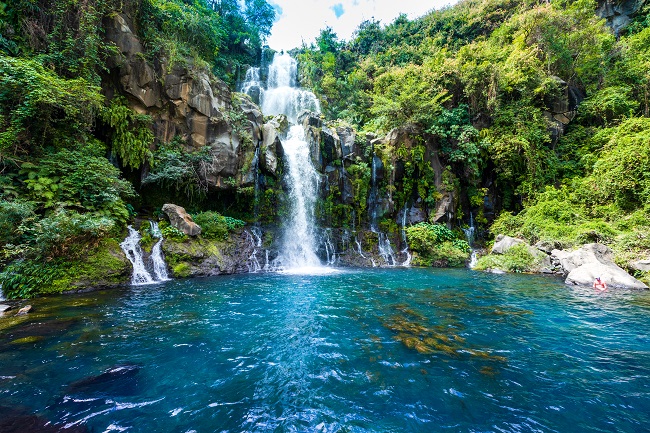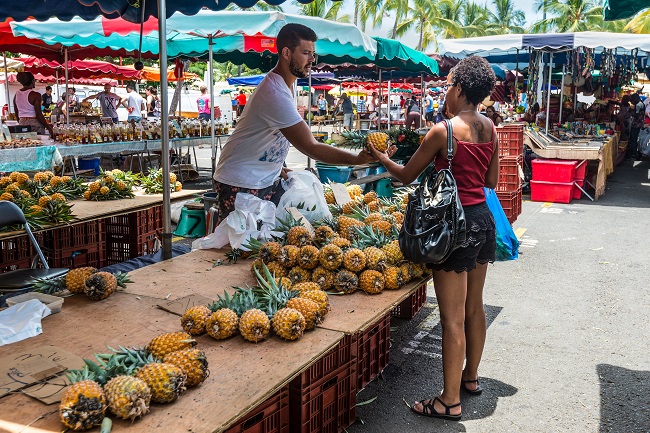Carnet de Voyage: Living la Vie Tropicale

Travel notes from the real France. Carnet de Voyage is a weekly personal travel story in France sent in by readers. If you’d like to write a story for Carnet de Voyage, head here for details on how to submit.
You can leave on a plane from Paris, travel 12 hours and 5,800 miles, and still land in France. Like the old saying that “the sun never sets on the British empire,” France has five overseas regions that have the same laws as they have in the mainland.
Last year in July, my wife and I visited one of these — Réunion Island — which lies in the South Indian Ocean, near Madagascar. We were visiting my daughter’s family; her husband is a French naval officer and he is being deployed there for a couple of years. The French Navy has a base in Réunion to patrol other French islands in the area and to supply research stations in the Antarctic. But it’s still France. Or, as we call it — ‘weird France.’
Think of it this way: Réunion is to France like Hawaii is to the U.S. The analogy is pretty good. Réunion is a tropical, volcanic island with cities along the coast and a mountainous and mostly uninhabited interior. Nearly a million people live there and they speak French as well as a dialect called Réunion Creole. But unlike Hawaii, Réunion has no indigenous people or culture. When it was “discovered” in the 16th century by Portuguese explorers, it was uninhabited.
France eventually gained control of the island and established it as a French overseas region. Other overseas regions include French Guiana, Guadeloupe and Martinique.
Due to its location, Réunion was eventually inhabited not only by French mainland natives, but also a mix of people from Africa, India and China, creating a diverse ethnic population known as creoles. So it’s French… but also not. Which accounts for the weird part.

A pineapple vendor on the Saint-Paul market in La Réunion © byvalet / shutterstock
You can drive through a small town in Réunion, past a French-style pâtisserie, and suddenly, you’ll see a street cart selling whole roast chickens, mango and papaya. You’ll see street signs in both French and Creole and in most classrooms, there are two teachers, one for each language.
Here are some other signs of ‘weird France.’
- Order quiche in a restaurant and you expect the traditional egg-and-blue-cheese variety, maybe with bacon or another meat. But in Réunion, tuna quiche is very popular. And once I got over the idea of the fish/egg combination, it was quite good. And you know the fish is fresh!
- Being in the southern hemisphere, the seasons are backwards. We landed in Réunion in July, which is mid-winter. A local woman said to my wife she was sorry we had to visit when “it was so cold.” Cold being a temperature that never got below 60 or above 72.
- France is known for its wine. But while grapes don’t grow in tropical Réunion, it does brew a popular local beer called “Bourbon.” The island was first named Bourbon after the House of Bourbon French dynasty and later changed to Réunion. The beer’s logo is the extinct Dodo bird that once inhabited nearby islands. So if you’re in a Réunion bar and you want to order two beers, you ask for “deux Dodos.”
- In Toulon, a French Mediterranean town where my daughter used to live, they had a lemon and an olive tree in their back yard. In Réunion, they have banana and avocado trees. Her kids pick and eat the small, sweet bananas right off the tree.
- We arrived at Réunion on Bastille Day, France’s national holiday. The hotel had a party that night around the pool, with a buffet and fireworks. Later, a band started up. They began playing a selection of American classic rock songs that you could hear in any US sports bar or French-American restaurant (“every breath you take…”). But then the music suddenly shifted to a local creole genre called Sega, with songs originally created to celebrate the end of slavery in 1848. It was rhythmic and energetic — like stumbling into a Baton Rouge roadhouse and hearing a local cajun band. And all the local people got up to dance.
- The French, especially Parisians, are stereotypically seen as rude or condescending to foreign visitors. The vibe in Réunion, however, is not uptight. Maybe it’s the shopping-mall weather or beautiful scenery, but people seem almost universally welcoming.
The couple who owned the Air B&B we stayed at grew up in Belgium and visited Réunion on a vacation. They liked it so much they went home, sold their house and returned to Réunion for good.
C’est la vie tropicale.
Read our other Carnet de Voyage entries here
Jeff Fister lives in a French-founded US city (St. Louis) with his wife, who is a French teacher. His daughter is married to a French naval officer and they live on the Reunion island. Jeff has been a writer/publisher for most of his career and, for fun, started the blog www.franco-files.net where he writes light-hearted and positive posts about France and his travels to l’Hexagone.
Lead photo credit : The waterfalls at the Egret pond in La Réunion © yggdrasill / shutterstock
Share to: Facebook Twitter LinkedIn Email
More in Carnet de Voyage, French culture, La Reunion, life in France, overseas territory
By Jeff Fister
Leave a reply
Your email address will not be published. Required fields are marked *



